| These highlights chronicle the year 2016. Created
incrementally as new photos were available, the year runs generally
"backwards" on this page. The abbreviation "MTY" means "Monterey County"
in the text below. Text by Don Roberson. Photos on this page
are copyrighted by the photographers to whom they are
attributed, and may not be reproduced in any form (including
other web sites) without the express consent of the photographer. |
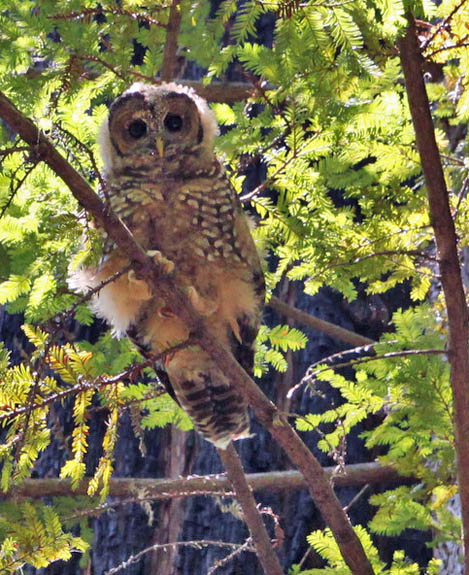
Since
it began on 22 July in Garrapata SP, the Soberanes fire has dominated
the news and many of the lives of Monterey County residents. As of this
writing (20 Aug) it has burned 84,000 acres and is only 60% contained.
It is cutting a huge swathe across the Ventana Wilderness. Fortunately,
most canyons along the Big Sur coast have escaped its path. This
fledgling Spotted Owl was found along the Cruikshank
Trail, south of Gorda, on 28 July (photo © Bill Bradlee), well
south and close to the San Luis Obispo Co. border. Spotted Owls hold
resident territories throughout the Big Sur area but are rarely seen or
photographed.
While summer temperatures soar in the
interior, in north coastal MTY the summer fog as been omnipresent
throughout July and August. With the loss of the Salinas WTP as
habitat, waders have been slim.
Some of the best
coastal birding has been at the Pajaro River mouth where it runs into
the sea not far south of the Santa Cruz County border. The best birds
found there in August were two juv Least Tern on 6 Aug (Brian L. Sullivan, Paul Fenwick, photo © Cooper Scollan, below).
Later,
a first-summer Franklin's Gull made appearances in the vicinity on 13
& 18 Aug (Rick Fournier, Jeff Poklen). There have also been
summering Brant, a couple Common Merganser, and a summering Long-tailed
Duck in the vicinity. |
|
|
0n 16 July, a 12-hour combo bird-and-whale watching trip aboard the Pt. Sur Clipper was idling over the middle of Monterey Bay
at the mouth of Soquel Canyon among thousands of migrating Red-necked
Phalaropes and 120 Humpback Whales (above; one whale,
lots of phalaropes © D. Roberson), not far from the Blackfin, a much larger whale-watching catamaran. About 4 p.m., suddenly ....
|
|
|
... an adult Nazca Booby sailed over the Blackfin
(above, ph D. Roberson). First spotted by Cooper Scollan (his shot
upper right), the booby was documented by Chris Hartzell (2 phs at
left), Beth Hamel (below), & others as it flew steadily south (ph
lower right, D. Roberson) until lost from view. |
|
|
|
Nazca Booby Sula granti was split from the worldwide pan-tropical Masked Booby S. dactylatra
about a decade ago based on genetics, assortative mating where ranges
meet, and plumage and structural differences. Nazca Booby breeds mostly
on the Galapagos Islands but a few pairs breed as far north as Islas
Revillagigedos, Mexico, and Clipperton Is. Adult Nazca differs from
Masked primarily by bill color. For Nazca, the bill is bright orange in
males, rosy-orange to coral red in females. For Masked, bill color is
the same in both sexes and ranges from bright yellow to yellow-green.
The bill is deeper-based in Nazca and has a dip along the culmen about
two-thirds of the way to the tip (the tip itself is often yellow).
Also, some adult Nazca are unique in having white central rectrices,
but many have all-black tails (Masked only has all-black tail). These
points are discussed with text and color photos in my 1998 article
"Sulids Unmasked: which large booby reaches California" in Field Notes 52: 276-287 (the predecessor of North American Birds
magazine). The identification of juvenal and subadults is complicated
until bill color changes. [A pdf of my article, including the cover
photo, is on-line
but unfortunately only some of the photos are shown in color.] Our
Monterey Bay booby has a conspicuous thick-based pink-orange bill
(possibly a female?). There are no good shots of the tail but the tail
appears to be in molt, with missing feathers in the center of tail (see
just above), which are possibly growing in as white feathers (the small
'going-away' photo), but hard to be certain on that point.
The
first fully confirmed record of Nazca Booby for California (and the ABA
area) was found dead on McGrath SB, Ventura Co., on 23 July 2013
[identified later by DNA analysis; see Yang, et al., W. Birds
47: 58-66]. An earlier record from 27 May 2001 — a first-cycle booby
that rode on a boat from Mexican to U.S. waters, and also later
identified by DNA — was not fully accepted by the CBRC because it
arrived on a boat. That's silly because boobies routinely rest on ships
at sea; they also rest on floating logs, kelp, driftwood, and
sea-turtles. Two more recent records off southern California — 27 June
2014 and 20 May 2015 — were adults that were photographed. Finally, a
subadult perched for a time at Pt. Pinos, MTY, on 1 Feb 2016 [see highlights from earlier this year].
Some wonder if this July bird could be the same booby as on Pt. Pinos
but 6 months have passed and the plumage is now quite different — so it
is anyone's guess. The CBRC has accepted 16 records of young boobies as
"Nazca/Masked" because identification of immatures remains difficult
and controversial.
|
|
|
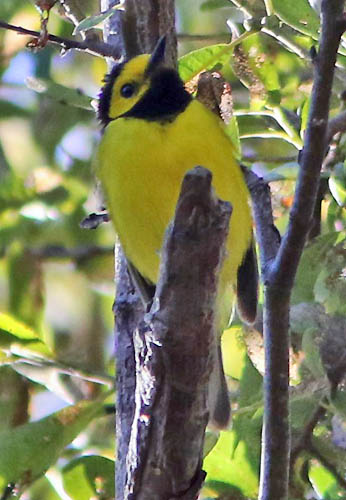 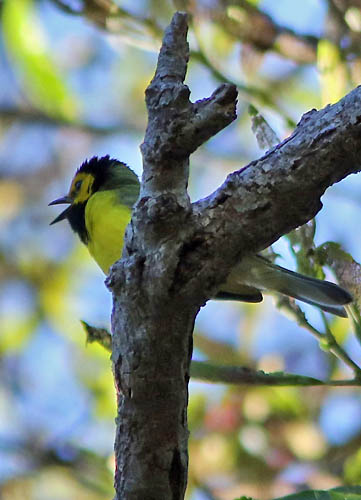 A male Hooded Warbler
dropped into downtown Monterey in July, where it sang up a storm
(photos above and right all from 9 July © D. Roberson). Found by
its song by Michael Rieser on 8 July at the intersection of El Dorado
and Munras, it frequented the deep ravine in Don Dahvee Park that day
and thereafter. It could be very difficult to see in the thick willow
understory above abundant Poison Oak, but its song carried for
distances [see Brian Sullivan's eBird checklist for 8 July
to listen to its song and its 'chip' note call]. Hooded is a colorful
warbler, but also note the large white tail spots visible in flight. A male Hooded Warbler
dropped into downtown Monterey in July, where it sang up a storm
(photos above and right all from 9 July © D. Roberson). Found by
its song by Michael Rieser on 8 July at the intersection of El Dorado
and Munras, it frequented the deep ravine in Don Dahvee Park that day
and thereafter. It could be very difficult to see in the thick willow
understory above abundant Poison Oak, but its song carried for
distances [see Brian Sullivan's eBird checklist for 8 July
to listen to its song and its 'chip' note call]. Hooded is a colorful
warbler, but also note the large white tail spots visible in flight.
There
are now at least 39 Hooded Warbler records in MTY, but this is the
first since 2009, some 7 years ago. Most have occurred between May and
July, and there have been years (1992, 1993, 1994, 2001) when we've had
4-6 birds during those spring-summer dates. Multiple birds have
oversummered at Big Sur R. mouth and also (once) at Carmel R. mouth. A
pair was confirmed nesting at Big Sur R. mouth (fledgling seen 6 Aug
2004), one of the very few breeding records for all of California.
Over-summering males have lingered as late as September or even October.
Before
this current male, the previous records were from 2009. A young male
was banded at BSOL in Aug 2009 but different females were in our
Pacific Grove birdbath on 28 May 2009 and in fall on 20 Oct 2009 (Rita
Carratello, Don Roberson). |
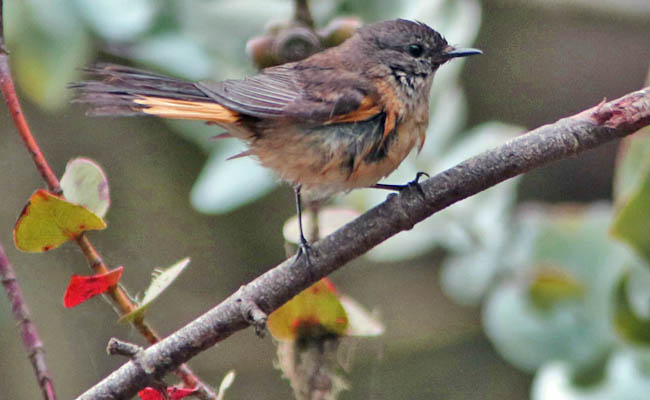
The 4th of July weekend was cold and dreary but this first–summer male American Redstart dropped into a Pacific Grove backyard 2 July for a quick bath — and then was gone (photo © D. Roberson).
|
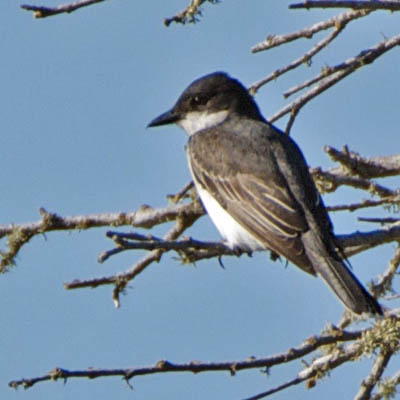 The best eastern vagrant in June was an Eastern Kingbird at Big Sur River lagoon on 17 June (Brian L. Sullivan, photo left © Cooper Scollan). The best eastern vagrant in June was an Eastern Kingbird at Big Sur River lagoon on 17 June (Brian L. Sullivan, photo left © Cooper Scollan).
Meanwhile,
at Zmudowski SB, where hordes of birders descended with "bittern fever"
(see below), up to 5 White-faced Ibis were present throughout June, as
was a summering female Redhead (D. Roberson et al.). On 28 June,
Michael Bolte photographed an adult Pectoral Sandpiper there, which we
treat as the first returning fall migrant of this species. It
represents the earliest fall migrant Pectoral ever in MTY.
An adult female Brown Booby
was seen from Pt. Pinos on 15 and 24 June; it was photographed from the
Point by Brian Sullivan on 15 June (below; © BL Sullivan).

|
Bitterns
were the lead story in June 2016. On 12 June, Cooper Scollan made two
impressive discoveries in the reedy edges of the freshwater pond at
Zmudowski SP. First, he heard a singing Least Bittern.
It has been 17 years since there had been a Least Bittern in MTY, and
this was the first to be singing [a soft, fast, "coo-coo-coo-coo" song,
there are tape-recordings on several eBird lists] on territory in this
county.
For several days the Least Bittern was
only heard singing or occasionally giving other calls, but then some
lucky observers saw it briefly in flight. Janet Leonard was the first
to photograph the male [on 19 June, near left © J. Leonard];
later, Carole Rose caught this nice flight photo [on 23 June, far
right, © C. Rose]. |
|
|
|
 The
prior records of MTY Least Bitterns include a prior record from
Zmudowski in fall migration [22 Sep 1994] and two August records of
fall migrants [Carmel R. mouth and Salinas R. mouth]. There are only 3
prior records of spring migrants, all in May or early June, from Calera
Canyon, from Pt. Sur [31 May–4 June 1999], and two were in the reeds at
Crespi Pond between 4–18 June 1988. The
prior records of MTY Least Bitterns include a prior record from
Zmudowski in fall migration [22 Sep 1994] and two August records of
fall migrants [Carmel R. mouth and Salinas R. mouth]. There are only 3
prior records of spring migrants, all in May or early June, from Calera
Canyon, from Pt. Sur [31 May–4 June 1999], and two were in the reeds at
Crespi Pond between 4–18 June 1988.
The second discovery was to confirm breeding of American Bittern
this year. During the drought of the last few years, bitterns seemed to
have abandoned Zmudowski pond, which had been the only known resident
pair. There loomed the possibility we had lost a breeding species in
MTY. This June, Cooper confirmed not only the presence of a pair — one
in flight on 12 June, right, © C. Scollan — he found half-grown
young! With many observers chasing the Least Bittern throughout June,
three youngsters were confirmed as the pair took turns feeding them in
the reeds. By 14 June, when this photo of two of them together was
taken (below, © Lisa Larson), they were growing larger but still
maintained clumps of wispy down-feathers on their crowns.
|
|
|
|
TOP
GO TO
HOME PAGE
TO MONTEREY
COUNTY
PAGE
TO BIRD
FAMILIES
OF THE WORLD
|




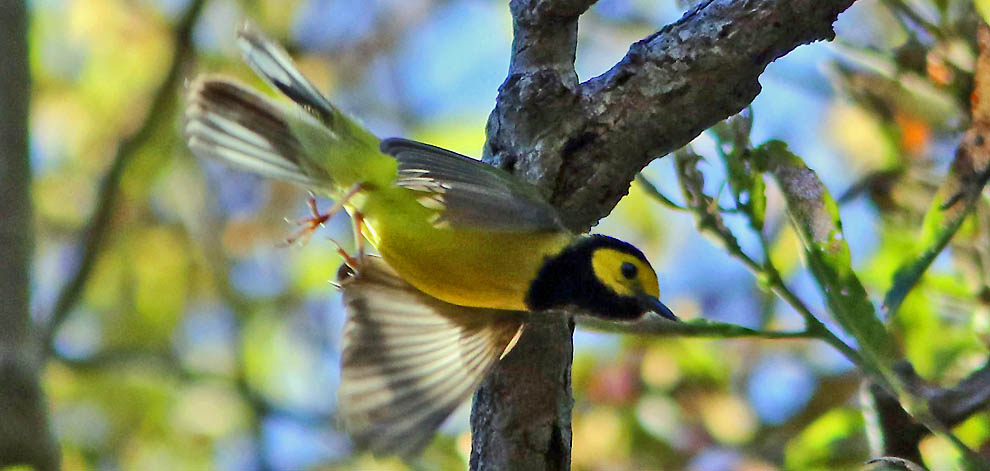
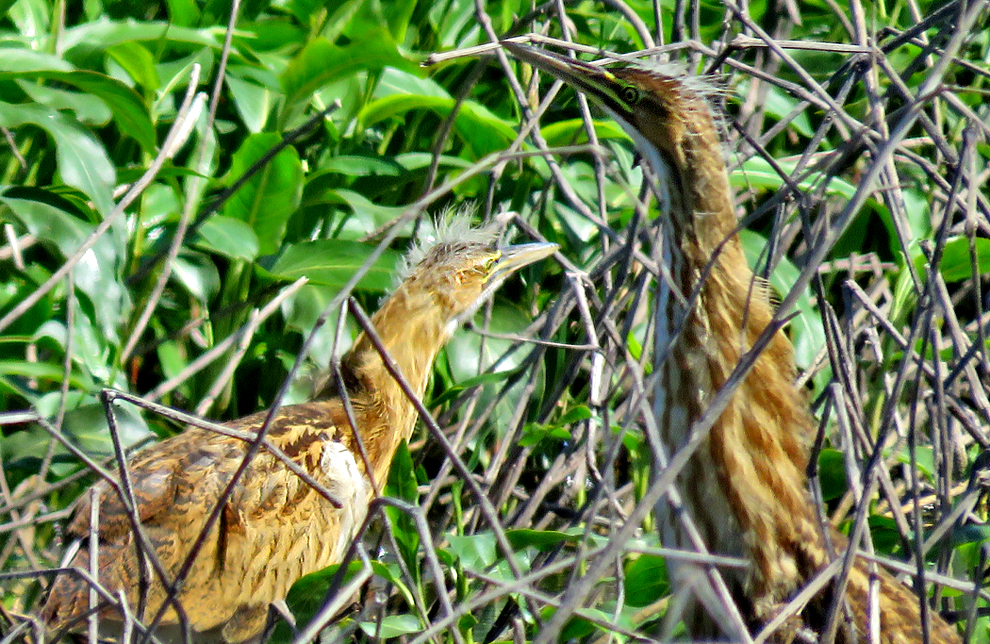


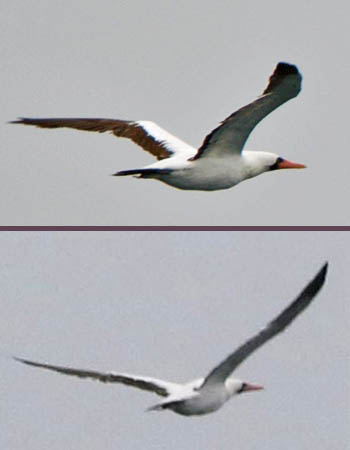

 A male Hooded Warbler
dropped into downtown Monterey in July, where it sang up a storm
(photos above and right all from 9 July © D. Roberson). Found by
its song by Michael Rieser on 8 July at the intersection of El Dorado
and Munras, it frequented the deep ravine in Don Dahvee Park that day
and thereafter. It could be very difficult to see in the thick willow
understory above abundant Poison Oak, but its song carried for
distances [see
A male Hooded Warbler
dropped into downtown Monterey in July, where it sang up a storm
(photos above and right all from 9 July © D. Roberson). Found by
its song by Michael Rieser on 8 July at the intersection of El Dorado
and Munras, it frequented the deep ravine in Don Dahvee Park that day
and thereafter. It could be very difficult to see in the thick willow
understory above abundant Poison Oak, but its song carried for
distances [see 
 The best eastern vagrant in June was an Eastern Kingbird at Big Sur River lagoon on 17 June (Brian L. Sullivan, photo left © Cooper Scollan).
The best eastern vagrant in June was an Eastern Kingbird at Big Sur River lagoon on 17 June (Brian L. Sullivan, photo left © Cooper Scollan). 
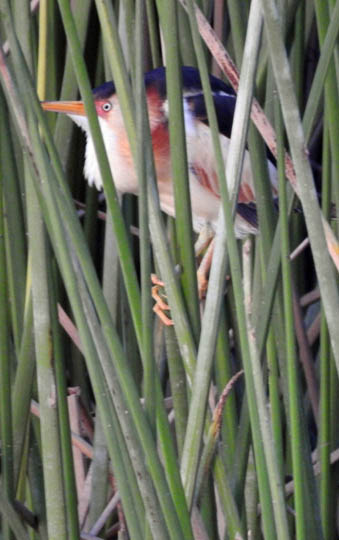
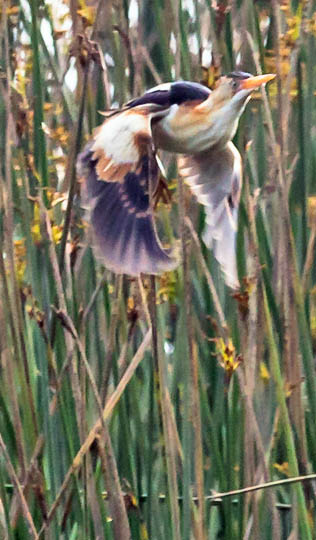
 The
prior records of MTY Least Bitterns include a prior record from
Zmudowski in fall migration [22 Sep 1994] and two August records of
fall migrants [Carmel R. mouth and Salinas R. mouth]. There are only 3
prior records of spring migrants, all in May or early June, from Calera
Canyon, from Pt. Sur [31 May–4 June 1999], and two were in the reeds at
Crespi Pond between 4–18 June 1988.
The
prior records of MTY Least Bitterns include a prior record from
Zmudowski in fall migration [22 Sep 1994] and two August records of
fall migrants [Carmel R. mouth and Salinas R. mouth]. There are only 3
prior records of spring migrants, all in May or early June, from Calera
Canyon, from Pt. Sur [31 May–4 June 1999], and two were in the reeds at
Crespi Pond between 4–18 June 1988.